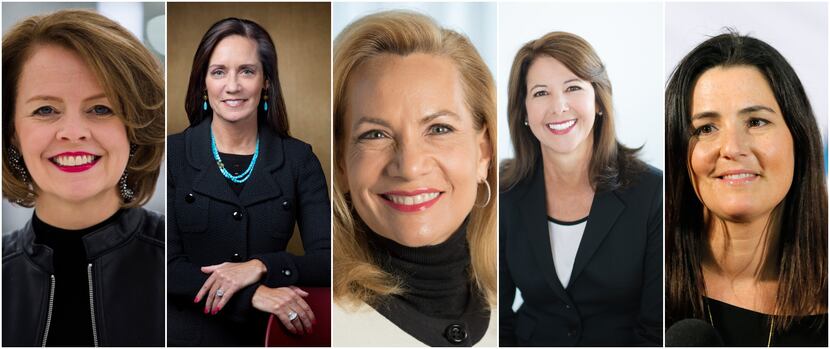AT&T’s Randall Stephenson went out on top.
Stephenson, who retired July 1, reclaimed his title as the highest-paid chief executive at Dallas-Fort Worth in The Dallas Morning News’ annual ranking of CEO pay at public companies. The ranking is compiled by Houston-based compensation firm Longnecker & Associates.
At age 60, Stephenson walked away from the telecommunications giant with a pension valued at $64 million, guaranteeing him over $230,000 a month for the rest of his life.
He had slipped to second last year after rising to the top of the list in 2017, when he passed Rex Tillerson, who fell out of first place in his final year as head of Exxon Mobil before joining the Trump administration.
Stephenson, who stepped into the CEO role in 2007, received $32 million in total direct compensation in 2019 — a 10% increase over 2018.
That’s significantly more than No. 2 on the list, Ronald Rittenmeyer of Tenet Healthcare Corp., who received $24.3 million. Rittenmeyer’s 62% year-over-year increase was mainly based on stock awards after he helped the company generate a 122% return for shareholders last year
Stephenson’s compensation included $5.3 million in annual incentives, $7.1 million in cash and $19.8 million in long-term incentives. His pay in recent years has been driven by stock performance, according to a filing with the Securities and Exchange Commission. In the past year, AT&T had a 46% return for shareholders while under pressure from activist investor Elliott Management to raise the stock price.
Stephenson has since been replaced by John Stankey, former CEO of WarnerMedia and former chief operating officer and president of AT&T. He was paid $22.5 million last year as the company’s No. 2 executive.
During Stephenson’s 35 years at AT&T — including 13 as CEO — he expanded the company’s revenue streams, buying DirecTV in 2015 for $67 billion and Time Warner in 2018 for $108.7 billion. There was also a failed attempt to buy T-Mobile that resulted in AT&T paying a $6 billion breakup fee.
“He was there in the previous era when AT&T was consolidated and he changed the strategy,” said Suresh Radhakrishnan, a professor of accounting and corporate governance at the University of Texas at Dallas.
As AT&T grew, so did Stephenson’s pay.
“The biggest predictor of CEO pay is the firm size, so if you want to maximize pay, then grow your company by acquiring other companies,” said Cynthia Devers, a business professor at Texas A&M who researches executive pay. “Most acquisitions don’t achieve the synergies they were expected to.”
Last year’s top-paid executive, At Home Group Inc.‘s Lewis “Lee” Bird III, didn’t break the top 100 this year, falling to 101 on the list after a 98% decrease in pay from $43 million to just over $1 million. His total compensation last year included stock options valued at $41.5 million that At Home later canceled at his request, effectively elevating Stephenson to the top again.
The Plano-based home decor chain increased its annual revenue from $1.2 billion in 2018 to $1.4 billion in 2019. However, total shareholder return plummeted 71% and investors grew weary of a debt-laden company trying to expand its 206 stores to 600.
This year, At Home suffered like many businesses in the first quarter, posting sales that were down 38% from the same period last year. But the company got a big boost in the second quarter with sales up 50% year-over-year as people use their extra time for home redecorating.
In general, base salaries for CEOs remain relatively flat from year to year — around $1 million — and only make up about 10% of their total compensation, said Ryan Colucci, senior associate at Compensation Advisory Partners in New York. Bonuses and longer-term incentives are constantly fluctuating.
While the average base salary for the 100 highest-paid CEOs increased less than 1% last year, the average total compensation for the group fell by 15.5%, according to Longnecker & Associates’ analysis. This year, median compensation fell nearly 8% to $5.4 million. Last year, median compensation rose 29% to $5.8 million.
With the economic downturn brought on by the pandemic, which has shuttered businesses for months at a time, the average CEO pay is likely to drop another 15% to 20% this year, said Chris Earnest, a Houston-based partner at Compensation Advisory Partners.
Three-fourths of CEOs will likely see a drop in pay, he said.
“I think we will see a dramatic decrease in CEO pay when proxies come out in 2021,” Earnest said.
Small companies, big fluctuations
Plano-based clinical-stage biopharmaceutical firm Reata, a Wall Street darling with 220 employees, sticks out on the list.
Its CEO, J. Warren Huff, saw the biggest year-over-year increase in his pay — a stunning 493.1% hike to $5.5 million. Last year, he didn’t receive option awards while this year he was awarded $4.4 million, according to a filing.
For 2019, the company boasted a 264% shareholder return. For the past three years, shareholders in the company, which hopes its kidney disease drug will be approved for sale this year, saw an 836% return.
Reata spent the biggest portion of its revenue on CEO pay in 2019. The company brought in $26.5 in revenue and signed off on $5.5 million for Huff.
“They’re a tiny company so they will see more fluctuations than larger companies,” said Kevin Kuschel, COO of Longnecker. “So it doesn’t surprise me to see a large one-time increase in long-term incentives to help motivate the CEO and keep him in his seat.”

5 women make 2020 list
Five women earned spots in this year’s ranking:
- Jill Soltau of J.C. Penney Company Inc. at 17th.
- Barbara Smith of Commercial Metals Co. at 29th.
- Lori Ryerkerk of Celanese Corp. at 42nd.
- Kimberly Lody of Capital Senior Living Corp at 60th.
- Mandy Ginsberg of Match Group at 68th.
A 5% representation among women is predictable, said Priyanka Dwivedi, an assistant professor at Texas A&M’s business school who researches gender and diversity among executives.
“Evidence shows that women receive lower pay relative to men in general and even in the upper ranks and echelons,” she said.
Smith frequently mentions her former boss at Pittsburgh-based Alcoa — where she worked for over 20 years starting as a systems analyst — for recognizing her potential and giving her opportunities to succeed. Dwivedi said her research shows that male predecessors play a large role in helping bring women into the upper ranks.
“One of the fundamental things to recognize, though, is that while predecessors can help women, they can also act as a barrier because not a lot of male executives are acting as allies, yet,” she said.
The COVID-19 pandemic might even be hindering progress in gender equality in the workplace, according to new research cited by Dwivedi.
“With school closures and people losing jobs, there’s a greater negative impact on women,” she said.
When in crisis mode — as nearly all businesses are right now — management attention can shift away from diversity and toward fighting off the immediate fire.
D-FW’s top 100 list reflects the gender diversity in the broader business world, which has a ratio of 19:1 for male to female CEOs, according to a 2019 study from S&P Global Market Intelligence’s quantamental research team.
CEO pay vs. worker pay
Growing income inequality in the U.S. is partly due to the disparity between what CEOs are paid and what they pay their workers. From 1978 to 2018, CEO compensation grew by 1,007.5% while wages for employees grew by only 11.9%, according to a 2019 report from Washington, D.C.-based Economic Policy Institute.
Starting in 2017, most publicly traded companies were required to report their CEO-to-worker pay ratio. This year, GameStop Corp. had the largest gap between its pay for CEO George Sherman, at over $12 million, and its median salary, which was a little over $11,000.
Retailers often have the largest gaps because its lowest employee ranks are paid significantly less than the lowest ranks at say, a software company like Plano-based Tyler Technologies, where median pay is $87,570 for a CEO-to-worker ratio of 47.9:1. That’s why industry context is important when looking at the measure.
“Almost by definition, retail companies will end up having a very large ratio,” Radhakrishnan said. “On the other hand, even the lowest employees at Google will probably have a master’s degree and demand higher compensation, so the ratio would be smaller.”
While most North Texans can’t imagine being paid $6.5 million a year, which was the average compensation of this year’s top 100, experts argue that the stress, time commitment and skill required to be a CEO deserve higher pay.
“They’re extremely exposed,” Kuschel said. “They have a lot of value tied up in a single entity. I’m talking about tens if not hundreds of millions that they’re forced to hold in their companies and when bad things happen in the market, they feel the pain more than most.”
With so much of their wealth tied up in companies, CEOs are only bringing home 30% to 40% of their total compensation each year, Kuschel said.
“They could lose hundreds of millions overnight,” he said. “We aren’t as exposed to major overnight losses. These are billionaire problems.”
CEO pay also continues to rise because even they compare themselves to their peers and want to be compensated at a similar or higher level, Devers said. And good CEOs are hard to come by.
“Think about the top athletes,” she said. “When they see another athlete making more than them, they renegotiate their pay. It’s the same in business for the top CEOs. There’s a lot of social comparisons.”
The COVID-19 effect
A number of CEOs, like Mark Zoradi of Cinemark or At Home’s Bird, have given up their salaries during the pandemic to show solidarity with the employees they’ve had to furlough. Others are taking pay cuts deeper than those seen during the recession, Earnest said.
“Any significant pay bump would look really bad with the number of layoffs and pay cuts,” he said. “It would seem tone-deaf.”
But companies are walking a tight rope because if the cuts are too deep, they could lose their best talent to a more generous competitor.
“Back to the athlete scenario, if a coach fires a top athlete, someone else hires them because so few people are skilled at it,” Devers said.
There is some debate about how sincere the pay cuts are and how long they will last. Historically, Devers said, executive pay cuts are short-lived.
“It’s hard to take away from people once they have it,” she said.
The pandemic could act as a reset on executive pay and could normalize some of the more egregious salaries, particularly for hard-hit industries such as retail and oil and gas, said Earnest, who focuses his research on the energy sector in Texas.
Other companies will have to decide whether their revenues will ever fully come back, said CAP’s Colucci. That also could affect CEO pay in the long term.
To sum it up, a cloud of uncertainty continues to linger heavily on the 2021 horizon for everyone — even those on top.
“2008 was a manmade crisis,” Radhakrishnan said. “It was bad but there was an overall sense that it was more controllable than this natural crisis.”

